Investment Portfolio Analysis: Performance, Selection, and Allocation
VerifiedAdded on 2023/06/10
|7
|1346
|383
Homework Assignment
AI Summary
This assignment provides detailed answers to questions related to portfolio performance analysis and investment decisions. It covers topics such as the significance of alpha value, asset allocation, security selection, and the Capital Asset Pricing Model (CAPM). The analysis includes calculations for expected returns, risk assessments using standard deviation, and the impact of market conditions on portfolio management strategies. The assignment also evaluates whether a manager's ability to generate alpha changes during the business cycle and provides relevant references for further study. It concludes with practical recommendations for investors based on quantitative analysis and risk-adjusted return metrics.
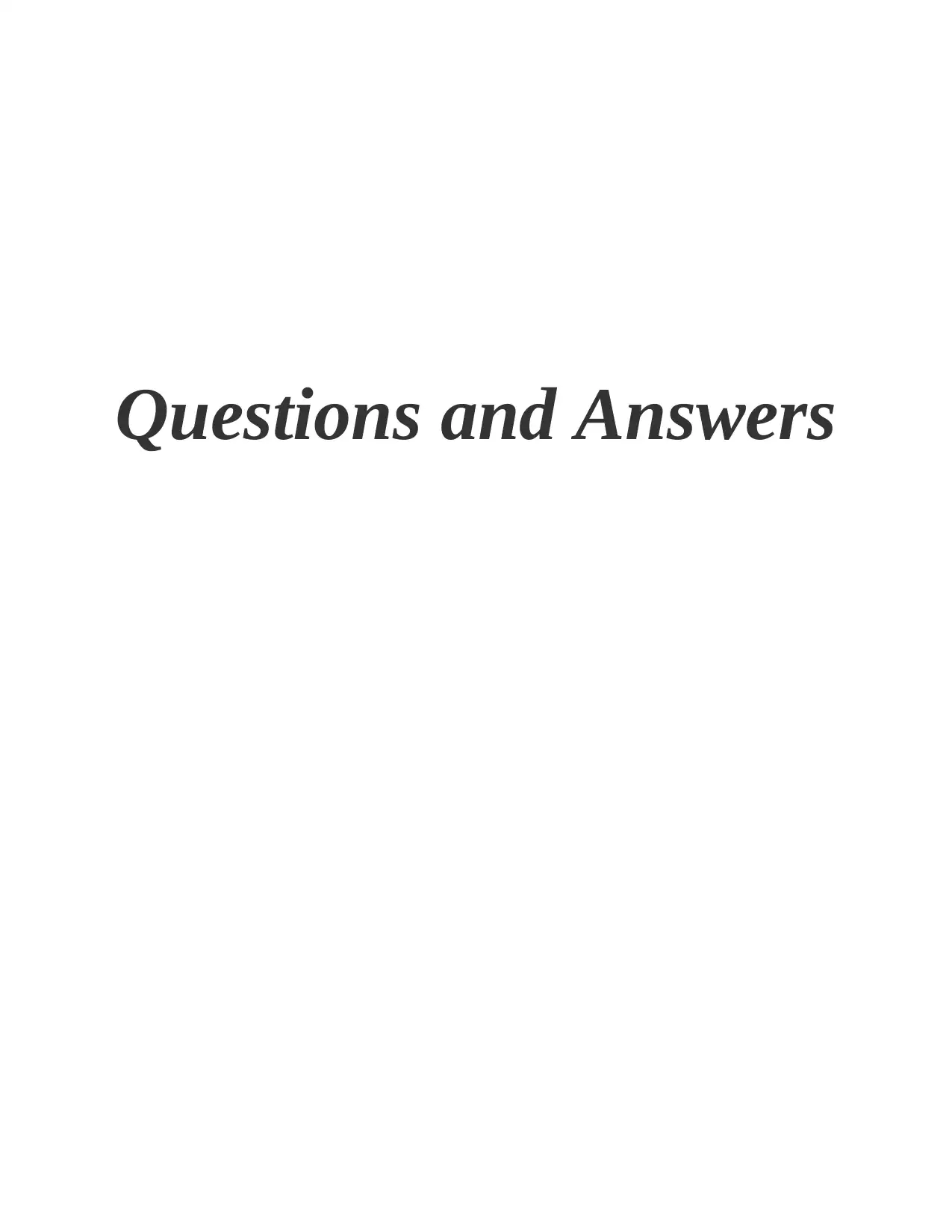
Questions and Answers
Paraphrase This Document
Need a fresh take? Get an instant paraphrase of this document with our AI Paraphraser
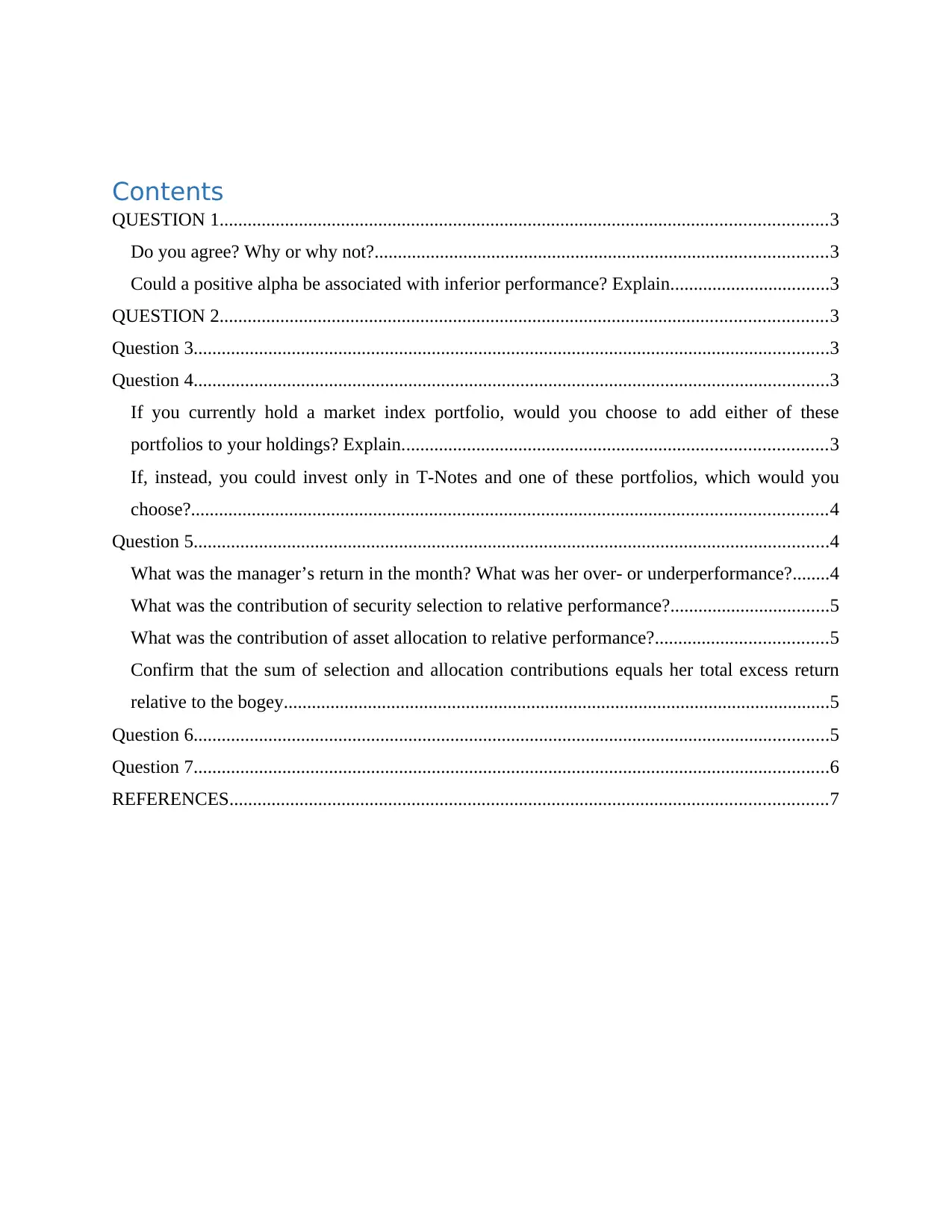
Contents
QUESTION 1..................................................................................................................................3
Do you agree? Why or why not?.................................................................................................3
Could a positive alpha be associated with inferior performance? Explain..................................3
QUESTION 2..................................................................................................................................3
Question 3........................................................................................................................................3
Question 4........................................................................................................................................3
If you currently hold a market index portfolio, would you choose to add either of these
portfolios to your holdings? Explain...........................................................................................3
If, instead, you could invest only in T-Notes and one of these portfolios, which would you
choose?........................................................................................................................................4
Question 5........................................................................................................................................4
What was the manager’s return in the month? What was her over- or underperformance?........4
What was the contribution of security selection to relative performance?..................................5
What was the contribution of asset allocation to relative performance?.....................................5
Confirm that the sum of selection and allocation contributions equals her total excess return
relative to the bogey.....................................................................................................................5
Question 6........................................................................................................................................5
Question 7........................................................................................................................................6
REFERENCES................................................................................................................................7
QUESTION 1..................................................................................................................................3
Do you agree? Why or why not?.................................................................................................3
Could a positive alpha be associated with inferior performance? Explain..................................3
QUESTION 2..................................................................................................................................3
Question 3........................................................................................................................................3
Question 4........................................................................................................................................3
If you currently hold a market index portfolio, would you choose to add either of these
portfolios to your holdings? Explain...........................................................................................3
If, instead, you could invest only in T-Notes and one of these portfolios, which would you
choose?........................................................................................................................................4
Question 5........................................................................................................................................4
What was the manager’s return in the month? What was her over- or underperformance?........4
What was the contribution of security selection to relative performance?..................................5
What was the contribution of asset allocation to relative performance?.....................................5
Confirm that the sum of selection and allocation contributions equals her total excess return
relative to the bogey.....................................................................................................................5
Question 6........................................................................................................................................5
Question 7........................................................................................................................................6
REFERENCES................................................................................................................................7
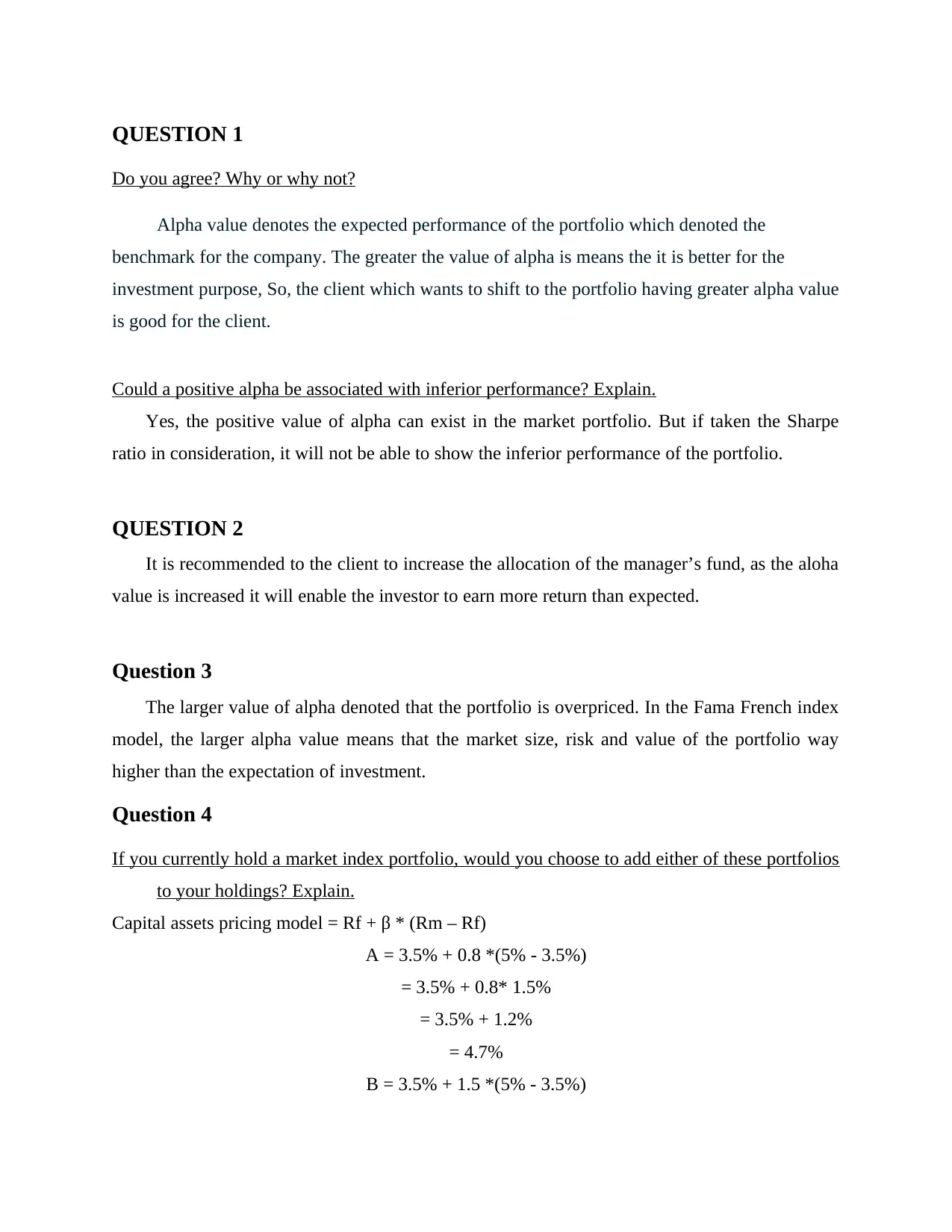
QUESTION 1
Do you agree? Why or why not?
Alpha value denotes the expected performance of the portfolio which denoted the
benchmark for the company. The greater the value of alpha is means the it is better for the
investment purpose, So, the client which wants to shift to the portfolio having greater alpha value
is good for the client.
Could a positive alpha be associated with inferior performance? Explain.
Yes, the positive value of alpha can exist in the market portfolio. But if taken the Sharpe
ratio in consideration, it will not be able to show the inferior performance of the portfolio.
QUESTION 2
It is recommended to the client to increase the allocation of the manager’s fund, as the aloha
value is increased it will enable the investor to earn more return than expected.
Question 3
The larger value of alpha denoted that the portfolio is overpriced. In the Fama French index
model, the larger alpha value means that the market size, risk and value of the portfolio way
higher than the expectation of investment.
Question 4
If you currently hold a market index portfolio, would you choose to add either of these portfolios
to your holdings? Explain.
Capital assets pricing model = Rf + β * (Rm – Rf)
A = 3.5% + 0.8 *(5% - 3.5%)
= 3.5% + 0.8* 1.5%
= 3.5% + 1.2%
= 4.7%
B = 3.5% + 1.5 *(5% - 3.5%)
Do you agree? Why or why not?
Alpha value denotes the expected performance of the portfolio which denoted the
benchmark for the company. The greater the value of alpha is means the it is better for the
investment purpose, So, the client which wants to shift to the portfolio having greater alpha value
is good for the client.
Could a positive alpha be associated with inferior performance? Explain.
Yes, the positive value of alpha can exist in the market portfolio. But if taken the Sharpe
ratio in consideration, it will not be able to show the inferior performance of the portfolio.
QUESTION 2
It is recommended to the client to increase the allocation of the manager’s fund, as the aloha
value is increased it will enable the investor to earn more return than expected.
Question 3
The larger value of alpha denoted that the portfolio is overpriced. In the Fama French index
model, the larger alpha value means that the market size, risk and value of the portfolio way
higher than the expectation of investment.
Question 4
If you currently hold a market index portfolio, would you choose to add either of these portfolios
to your holdings? Explain.
Capital assets pricing model = Rf + β * (Rm – Rf)
A = 3.5% + 0.8 *(5% - 3.5%)
= 3.5% + 0.8* 1.5%
= 3.5% + 1.2%
= 4.7%
B = 3.5% + 1.5 *(5% - 3.5%)
⊘ This is a preview!⊘
Do you want full access?
Subscribe today to unlock all pages.

Trusted by 1+ million students worldwide
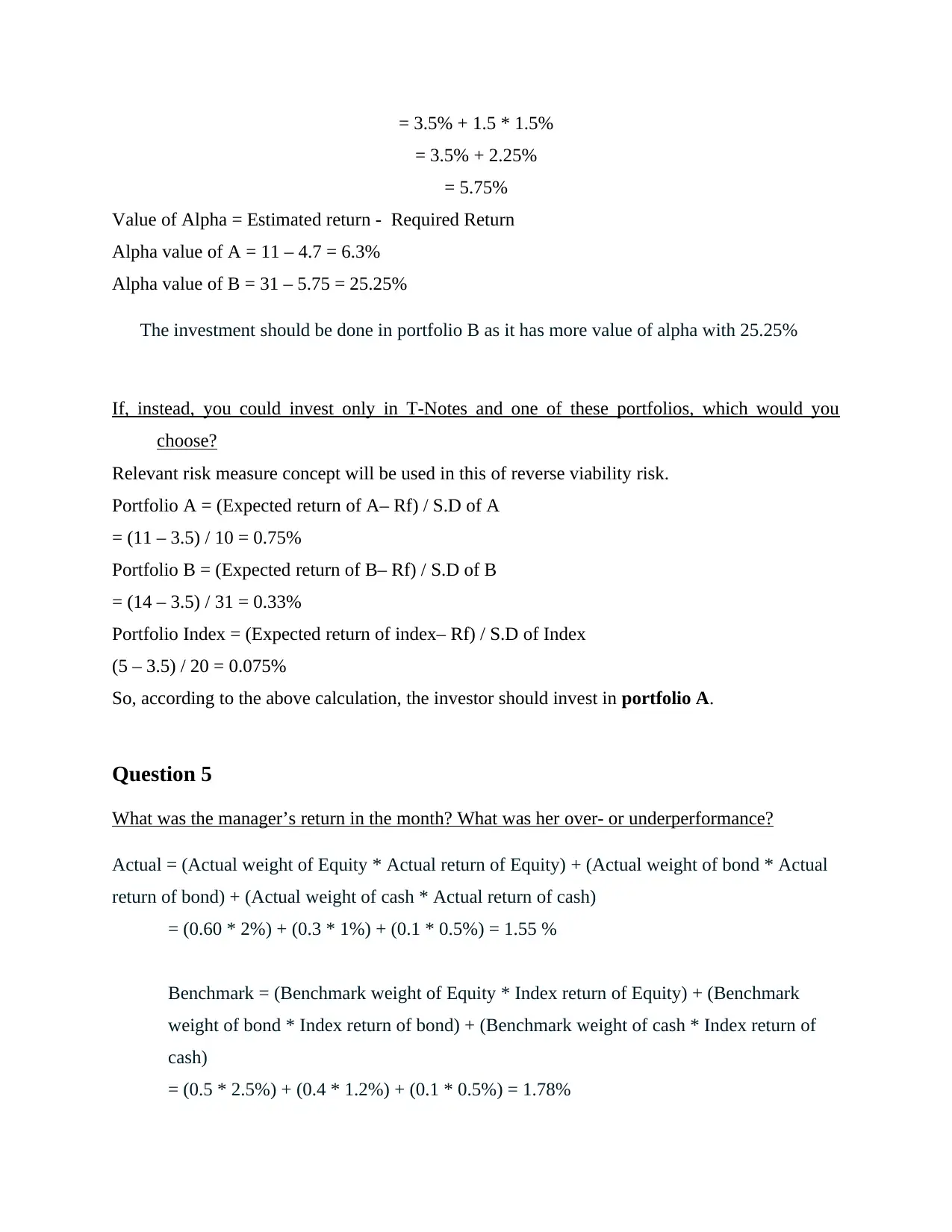
= 3.5% + 1.5 * 1.5%
= 3.5% + 2.25%
= 5.75%
Value of Alpha = Estimated return - Required Return
Alpha value of A = 11 – 4.7 = 6.3%
Alpha value of B = 31 – 5.75 = 25.25%
The investment should be done in portfolio B as it has more value of alpha with 25.25%
If, instead, you could invest only in T-Notes and one of these portfolios, which would you
choose?
Relevant risk measure concept will be used in this of reverse viability risk.
Portfolio A = (Expected return of A– Rf) / S.D of A
= (11 – 3.5) / 10 = 0.75%
Portfolio B = (Expected return of B– Rf) / S.D of B
= (14 – 3.5) / 31 = 0.33%
Portfolio Index = (Expected return of index– Rf) / S.D of Index
(5 – 3.5) / 20 = 0.075%
So, according to the above calculation, the investor should invest in portfolio A.
Question 5
What was the manager’s return in the month? What was her over- or underperformance?
Actual = (Actual weight of Equity * Actual return of Equity) + (Actual weight of bond * Actual
return of bond) + (Actual weight of cash * Actual return of cash)
= (0.60 * 2%) + (0.3 * 1%) + (0.1 * 0.5%) = 1.55 %
Benchmark = (Benchmark weight of Equity * Index return of Equity) + (Benchmark
weight of bond * Index return of bond) + (Benchmark weight of cash * Index return of
cash)
= (0.5 * 2.5%) + (0.4 * 1.2%) + (0.1 * 0.5%) = 1.78%
= 3.5% + 2.25%
= 5.75%
Value of Alpha = Estimated return - Required Return
Alpha value of A = 11 – 4.7 = 6.3%
Alpha value of B = 31 – 5.75 = 25.25%
The investment should be done in portfolio B as it has more value of alpha with 25.25%
If, instead, you could invest only in T-Notes and one of these portfolios, which would you
choose?
Relevant risk measure concept will be used in this of reverse viability risk.
Portfolio A = (Expected return of A– Rf) / S.D of A
= (11 – 3.5) / 10 = 0.75%
Portfolio B = (Expected return of B– Rf) / S.D of B
= (14 – 3.5) / 31 = 0.33%
Portfolio Index = (Expected return of index– Rf) / S.D of Index
(5 – 3.5) / 20 = 0.075%
So, according to the above calculation, the investor should invest in portfolio A.
Question 5
What was the manager’s return in the month? What was her over- or underperformance?
Actual = (Actual weight of Equity * Actual return of Equity) + (Actual weight of bond * Actual
return of bond) + (Actual weight of cash * Actual return of cash)
= (0.60 * 2%) + (0.3 * 1%) + (0.1 * 0.5%) = 1.55 %
Benchmark = (Benchmark weight of Equity * Index return of Equity) + (Benchmark
weight of bond * Index return of bond) + (Benchmark weight of cash * Index return of
cash)
= (0.5 * 2.5%) + (0.4 * 1.2%) + (0.1 * 0.5%) = 1.78%
Paraphrase This Document
Need a fresh take? Get an instant paraphrase of this document with our AI Paraphraser
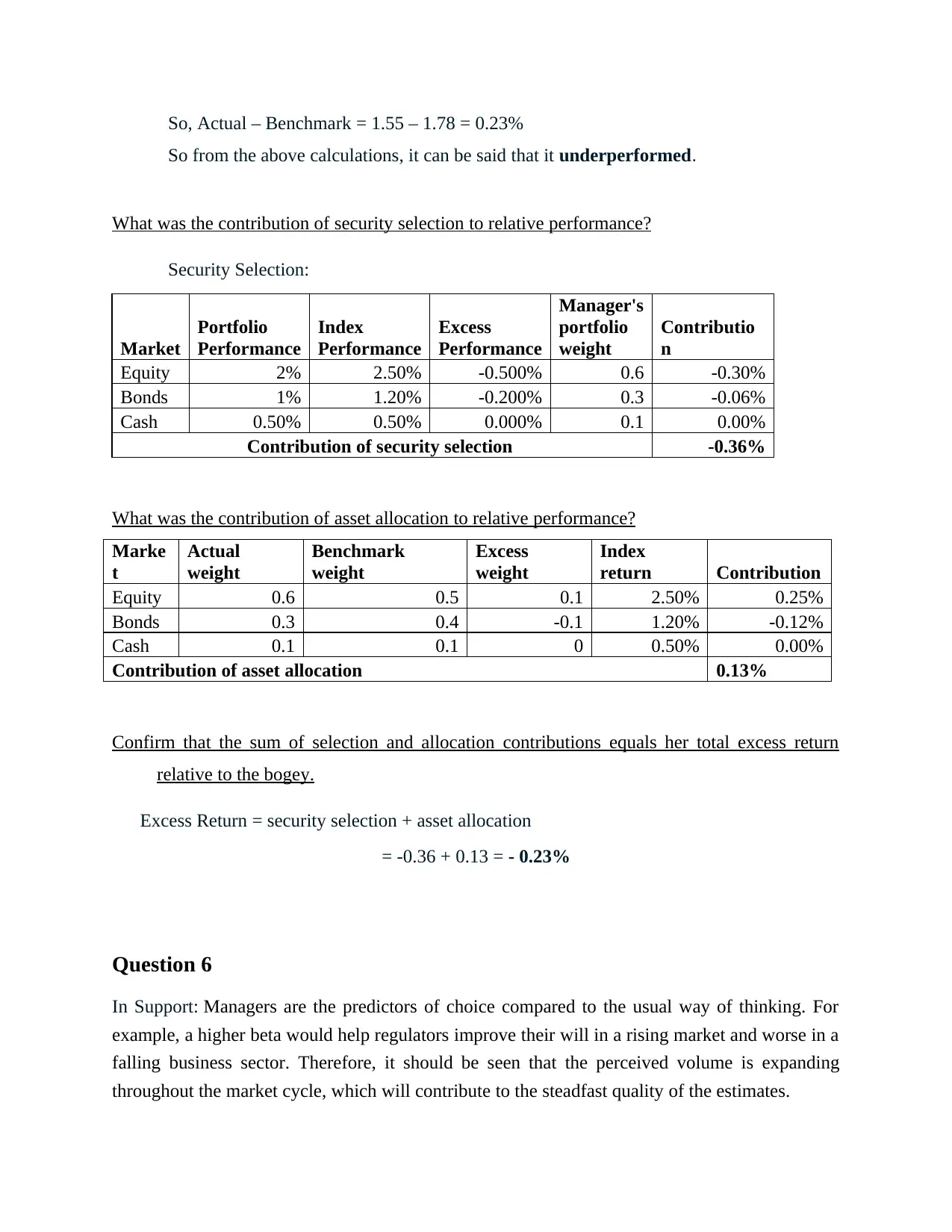
So, Actual – Benchmark = 1.55 – 1.78 = 0.23%
So from the above calculations, it can be said that it underperformed.
What was the contribution of security selection to relative performance?
Security Selection:
Market
Portfolio
Performance
Index
Performance
Excess
Performance
Manager's
portfolio
weight
Contributio
n
Equity 2% 2.50% -0.500% 0.6 -0.30%
Bonds 1% 1.20% -0.200% 0.3 -0.06%
Cash 0.50% 0.50% 0.000% 0.1 0.00%
Contribution of security selection -0.36%
What was the contribution of asset allocation to relative performance?
Marke
t
Actual
weight
Benchmark
weight
Excess
weight
Index
return Contribution
Equity 0.6 0.5 0.1 2.50% 0.25%
Bonds 0.3 0.4 -0.1 1.20% -0.12%
Cash 0.1 0.1 0 0.50% 0.00%
Contribution of asset allocation 0.13%
Confirm that the sum of selection and allocation contributions equals her total excess return
relative to the bogey.
Excess Return = security selection + asset allocation
= -0.36 + 0.13 = - 0.23%
Question 6
In Support: Managers are the predictors of choice compared to the usual way of thinking. For
example, a higher beta would help regulators improve their will in a rising market and worse in a
falling business sector. Therefore, it should be seen that the perceived volume is expanding
throughout the market cycle, which will contribute to the steadfast quality of the estimates.
So from the above calculations, it can be said that it underperformed.
What was the contribution of security selection to relative performance?
Security Selection:
Market
Portfolio
Performance
Index
Performance
Excess
Performance
Manager's
portfolio
weight
Contributio
n
Equity 2% 2.50% -0.500% 0.6 -0.30%
Bonds 1% 1.20% -0.200% 0.3 -0.06%
Cash 0.50% 0.50% 0.000% 0.1 0.00%
Contribution of security selection -0.36%
What was the contribution of asset allocation to relative performance?
Marke
t
Actual
weight
Benchmark
weight
Excess
weight
Index
return Contribution
Equity 0.6 0.5 0.1 2.50% 0.25%
Bonds 0.3 0.4 -0.1 1.20% -0.12%
Cash 0.1 0.1 0 0.50% 0.00%
Contribution of asset allocation 0.13%
Confirm that the sum of selection and allocation contributions equals her total excess return
relative to the bogey.
Excess Return = security selection + asset allocation
= -0.36 + 0.13 = - 0.23%
Question 6
In Support: Managers are the predictors of choice compared to the usual way of thinking. For
example, a higher beta would help regulators improve their will in a rising market and worse in a
falling business sector. Therefore, it should be seen that the perceived volume is expanding
throughout the market cycle, which will contribute to the steadfast quality of the estimates.
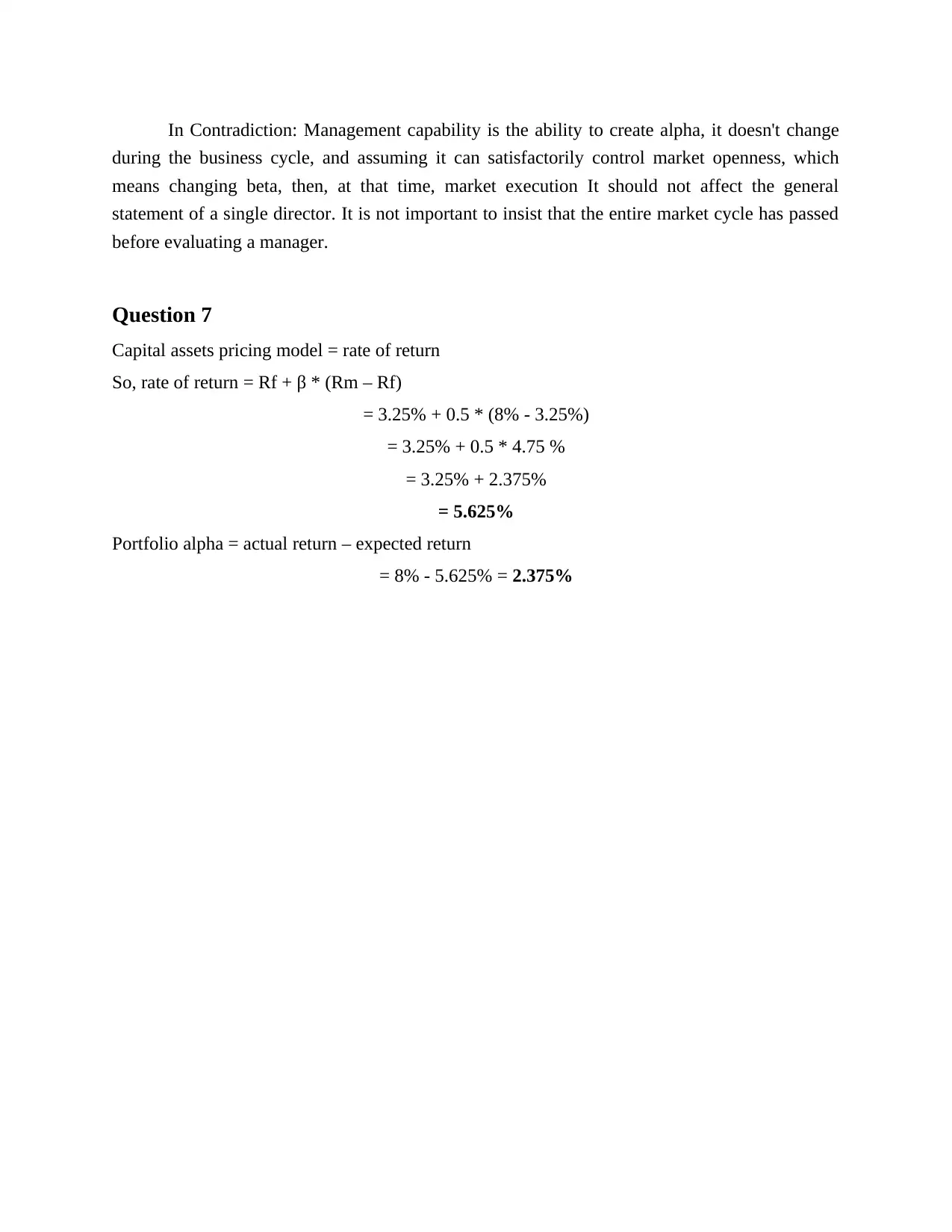
In Contradiction: Management capability is the ability to create alpha, it doesn't change
during the business cycle, and assuming it can satisfactorily control market openness, which
means changing beta, then, at that time, market execution It should not affect the general
statement of a single director. It is not important to insist that the entire market cycle has passed
before evaluating a manager.
Question 7
Capital assets pricing model = rate of return
So, rate of return = Rf + β * (Rm – Rf)
= 3.25% + 0.5 * (8% - 3.25%)
= 3.25% + 0.5 * 4.75 %
= 3.25% + 2.375%
= 5.625%
Portfolio alpha = actual return – expected return
= 8% - 5.625% = 2.375%
during the business cycle, and assuming it can satisfactorily control market openness, which
means changing beta, then, at that time, market execution It should not affect the general
statement of a single director. It is not important to insist that the entire market cycle has passed
before evaluating a manager.
Question 7
Capital assets pricing model = rate of return
So, rate of return = Rf + β * (Rm – Rf)
= 3.25% + 0.5 * (8% - 3.25%)
= 3.25% + 0.5 * 4.75 %
= 3.25% + 2.375%
= 5.625%
Portfolio alpha = actual return – expected return
= 8% - 5.625% = 2.375%
⊘ This is a preview!⊘
Do you want full access?
Subscribe today to unlock all pages.

Trusted by 1+ million students worldwide
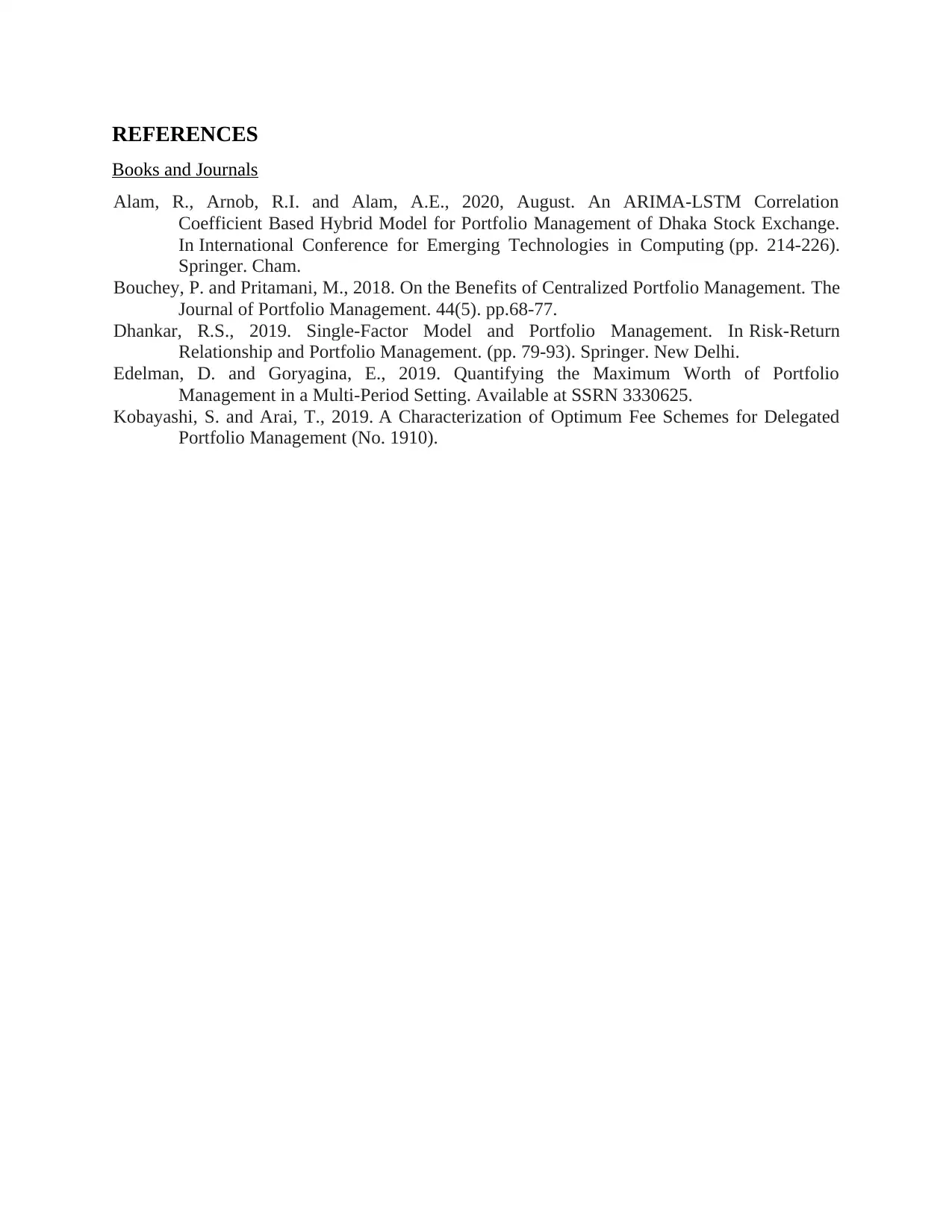
REFERENCES
Books and Journals
Alam, R., Arnob, R.I. and Alam, A.E., 2020, August. An ARIMA-LSTM Correlation
Coefficient Based Hybrid Model for Portfolio Management of Dhaka Stock Exchange.
In International Conference for Emerging Technologies in Computing (pp. 214-226).
Springer. Cham.
Bouchey, P. and Pritamani, M., 2018. On the Benefits of Centralized Portfolio Management. The
Journal of Portfolio Management. 44(5). pp.68-77.
Dhankar, R.S., 2019. Single-Factor Model and Portfolio Management. In Risk-Return
Relationship and Portfolio Management. (pp. 79-93). Springer. New Delhi.
Edelman, D. and Goryagina, E., 2019. Quantifying the Maximum Worth of Portfolio
Management in a Multi-Period Setting. Available at SSRN 3330625.
Kobayashi, S. and Arai, T., 2019. A Characterization of Optimum Fee Schemes for Delegated
Portfolio Management (No. 1910).
Books and Journals
Alam, R., Arnob, R.I. and Alam, A.E., 2020, August. An ARIMA-LSTM Correlation
Coefficient Based Hybrid Model for Portfolio Management of Dhaka Stock Exchange.
In International Conference for Emerging Technologies in Computing (pp. 214-226).
Springer. Cham.
Bouchey, P. and Pritamani, M., 2018. On the Benefits of Centralized Portfolio Management. The
Journal of Portfolio Management. 44(5). pp.68-77.
Dhankar, R.S., 2019. Single-Factor Model and Portfolio Management. In Risk-Return
Relationship and Portfolio Management. (pp. 79-93). Springer. New Delhi.
Edelman, D. and Goryagina, E., 2019. Quantifying the Maximum Worth of Portfolio
Management in a Multi-Period Setting. Available at SSRN 3330625.
Kobayashi, S. and Arai, T., 2019. A Characterization of Optimum Fee Schemes for Delegated
Portfolio Management (No. 1910).
1 out of 7
Your All-in-One AI-Powered Toolkit for Academic Success.
+13062052269
info@desklib.com
Available 24*7 on WhatsApp / Email
![[object Object]](/_next/static/media/star-bottom.7253800d.svg)
Unlock your academic potential
Copyright © 2020–2025 A2Z Services. All Rights Reserved. Developed and managed by ZUCOL.